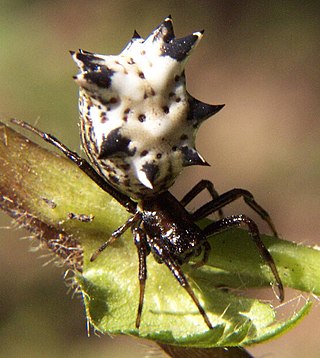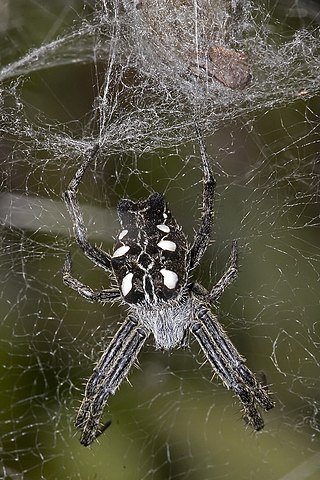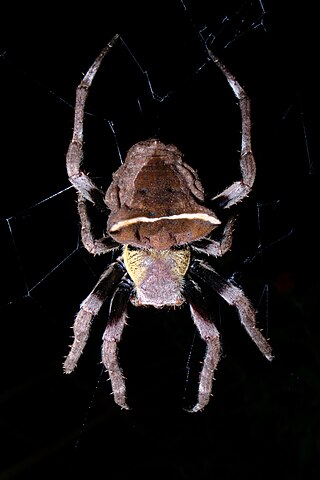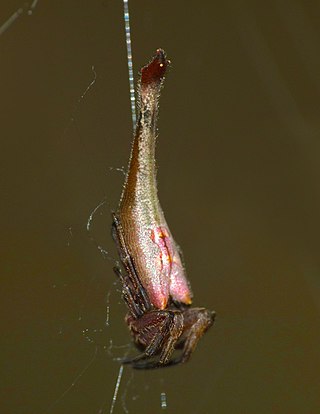
The genus Argiope includes rather large spiders that often have a strikingly coloured abdomen. These spiders are distributed throughout the world. Most countries in tropical or temperate climates host one or more species that are similar in appearance. The etymology of Argiope is from a Latin word argentum meaning silver. The carapace of Argiope species is typically covered in silvery hairs, and when crawling in the sun, they reflect it in a way that gives them a metallic, white appearance.

Orb-weaver spiders are members of the spider family Araneidae. They are the most common group of builders of spiral wheel-shaped webs often found in gardens, fields, and forests. The English word "orb" can mean "circular", hence the English name of the group. Araneids have eight similar eyes, hairy or spiny legs, and no stridulating organs.
Benoy Krishna Tikader (1928–1994) was an Indian arachnologist and zoologist and a leading expert on Indian spiders in his time. He worked in the Zoological Survey of India and published the Handbook of Indian Spiders in 1987. The book describes 40 families and 1066 species of India, many of which were described by Tikader himself. The handbook is a guide to all arachnids including scorpions, and not just spiders. He was also a popular scientific author in his native language of Bengali, and was the author of Banglar Makorsha for the layman.

A stabilimentum, also known as a web decoration, is a conspicuous silk structure included in the webs of some species of orb-web spider. Its function is a subject of debate.

A bolas spider is a member of the orb-weaver spider that, instead of spinning a typical orb web, hunts by using one or more sticky "capture blobs" on the end of a silk line, known as a "bolas". By swinging the bolas at flying male moths or moth flies nearby, the spider may snag its prey rather like a fisherman snagging a fish on a hook. Because of this, they are also called angling or fishing spiders. The prey is lured to the spider by the production of up to three sex pheromone-analogues.

Micrathena gracilis is a spider in the family Araneidae (orb-weavers), commonly known as the spined micrathena or castleback orbweaver. This spider spins a moderately large and very tightly coiled web. The spiders themselves are small and can be found to be anywhere from 4.2 mm to 10.8 mm long. Its venom is harmless to humans. M. gracilis is unique in appearance due to its large spiky abdomen and black and white bodies. Certain spiders of this species can also display a yellow color on the sides of their bodies. These spiders can be seen most active during the end of the summer and beginning of fall. M. gracilis is diurnal and are rarely ever seen active at night.

Ordgarius is a genus of orb-weaver spiders first described by Eugen von Keyserling in 1886. Adult females of the genus are bolas spiders, capturing their prey with one or more sticky drops at the end of a single line of silk rather than in a web. Males and juvenile females capture their prey directly with their legs.

Arachnura, also known as drag-tailed spider, scorpion-tailed spider and scorpion spider, is a genus of orb-weaver spiders that was first described by A. Vinson in 1863. They are distributed across Australasia, Southern and Eastern Asia with one species from Africa. Females can grow up to 1 to 3 centimetres long, while males reach only 2 millimetres (0.079 in) long. The name is a combination of the Ancient Greek "arachne-" (ἀράχνη) and "uro" (οὐρά), meaning "tail". The tails are only present on females, but unlike the common names suggests, these spiders aren't related to scorpions. They curl up their tails when disturbed, but they are completely harmless. Bites are rare, and result in minor symptoms such as local pain and swelling. They stay at the middle of their web day and night, and their bodies mimic plant litter, such as fallen flowers, twigs, or dead leaves.

Larinioides sclopetarius, commonly called bridge-spider or gray cross-spider, is a relatively large orb-weaver spider with Holarctic distribution. These spiders originated in Europe, have been observed as south as the Mediterranean Coast and as north as Finland, and have been introduced to North America. They are often found on bridges, especially near light and over water. The species tends to live on steel objects and is seldom seen on vegetation. Females reach a body length of 10–14 mm, and males 8–9 mm. Their orb webs can have diameters of up to 70 cm.

Argiope protensa, commonly known as the tailed grass spider or teardrop spider, is a species of spider in the orb weaver family, Araneidae. This species is fairly common and widespread in Australasia, but like many spider species, little is known of its ecology, biology, or life history.

Dolichognatha is a genus of tropical and subtropical long-jawed orb-weavers that was first described by Octavius Pickard-Cambridge in 1869. Originally placed with the Archaeidae, it was transferred to the Araneidae in 1967, and to the Tetragnathidae in 1981.

Cyrtophora citricola, also known as the tropical tent-web spider, is an orb-weaver spider in the family Araneidae. It is found in Asia, Africa, Australia, Costa Rica, Hispaniola, Colombia, and Southern Europe and in 2000, it was discovered in Florida. C. citricola differs from many of its close relatives due its ability to live in a wide variety of environments. In North America and South America, the spider has caused extensive damage to agricultural operations.

Araneus mitificus, commonly known as the kidney garden spider or pale orb weaver is a species of orb-weaver spider found in South, East, and Southeast Asia.

Parawixia dehaani, known in Australia as the abandoned-web orb-weaver, is a species of orb weaver spider from the family Araneidae which is widely distributed in Australasia and eastern Asia. It is common in gardens, leading to it sometimes being known by the name common garden spider. The specific name is sometimes spelt dehaanii.

Macracantha is a genus of Asian orb-weaver spiders recognized as containing the species, Macracantha arcuata., although some schemes also recognise inclusion of Gasteracantha hasselti in this genus. Macracantha is notable for the extremely long, curved spines on the abdomens of female members of the genus; Eugène Simon created the taxon name from the Greek words μακρός and ἄκανθα (spine). It occurs from India and China through Southeast Asia to Indonesia.

Pasilobus is a genus of orb-weaver spiders first described by Eugène Simon in 1895.

Paraverrucosa is a genus of orb-weaver spiders first described by Cândido Firmino de Mello-Leitão in 1939 to contain the type species, Paraverrucosa neglecta. Each of the four species have been moved around between Wagneriana, Edricus, and Verrucosa, but were all moved to this genus in 2020.

Cyrtarachninae is a subfamily of spiders in the family Araneidae. The group has been circumscribed in several different ways. It originated as the group Cyrtarachneae, described by Eugène Simon in 1892. The group was later treated at different ranks: as a tribe, both under Simon's name and as Cyrtarachnini, and as the subfamily Cyrtarachninae. Circumscriptions have varied. The broadest circumscription, Cyrtarachninae sensu lato (s.l.), includes three of Simon's original groups, including the bolas spiders. Unlike most araneids, members of the subfamily do not construct orb webs, some not using webs at all to capture prey, some using one or more sticky drops on a single line, while others construct webs with few widely spaced non-spiral threads, some triangular. Many have been shown to attract prey by producing analogues of insect sex pheromones, particularly to attract male moths. Adult females may mimic snails, bird droppings and other objects, and so are able to remain exposed during the day time, capturing prey at night.

Arachnura feredayi, the tailed forest spider, scorpion spider or drag-tailed spider, is endemic to New Zealand. It is known for the distinctive tapering body shape in females, which are also much larger than males, and for producing vertical columns of egg sacs in their webs.
Popperaneus is a small genus of South American orb-weaver spiders first described by J. Cabra-García and Gustavo Hormiga in 2020. As of November 2021 it contains only two species, both transferred from Wagneria: P. gavensis and P. iguape.

















